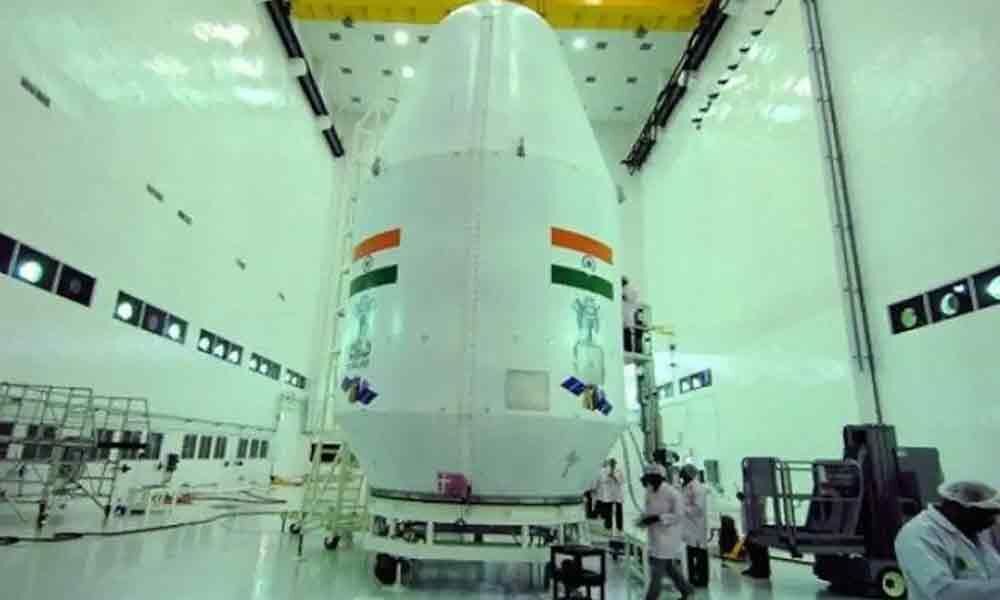Live
- Police book case against KTR for unauthorised rally
- Literature crucial in nurturing creativity
- Academicians debate on trends observed in 2024 General Elections
- Adah Sharma to perform Shiv Tandav stotram at the MahaKumbh mela
- Haryana Guv urges TG, AP CMs to implement NEP-2020
- Tail-end farmers should get irrigation water, says Uttam
- SpinSci to churn out 1K AI-based jobs in Telangana
- Kothapalli-Manoharabad rly line to be operationalised by 2027
- Industrial production at 6-mth high in Nov
- Traffic restrictions on heavy vehicles in Rachakonda
Just In
Chandrayaan 2: A revolutionary space mission


Incontestably, Indian Space Research Organisation (ISRO) has been very efficacious in almost all of its space missions.
Incontestably, Indian Space Research Organisation (ISRO) has been very efficacious in almost all of its space missions.
India's first endeavour into the interplanetary space, Mars Orbiter Mission (MOM), has been exploring and observing Mars' surface features, morphology, mineralogy and the Martian atmosphere.
After completing an interplanetary journey of more than 10 months, covering a distance of 780 million km, the Mars Orbiter Mission — more aptly known as Mangalyaan — has entered the orbit around Mars on September 24, 2014. Mangalyaan is one of the major projects ever undertaken by the ISRO.
Maintaining the same cadence, on June 18, 2019, ISRO has proudly announced that the Chandrayaan 2 concocts to explore the whodunits of the Moon's South Polar region in 2019 — yet again another mission to make every Indian proud.
As regarded by the ISRO, it is a parallel expedition to 1909's Nimrod Expedition, which is also known as the British Antarctic Expedition — Ernest Shackleton's mission to explore the Earth's South Pole in 1909. It was the first of three expeditions to the Antarctic, whose main target was to be first to the South Pole.
Just like Nirmod's expedition to Earth's South Pole region, on its successful accomplishment, Chandrayaan 2 would become the first-ever expedition to reach the Moon's South Pole.
The ISRO aptly titled this mission period of 110 years (from 1909 to 2019) between these two expeditions as, "From Pole to Pole".
Chandrayaan 2 is the scientific abdication of Chandrayaan 1. The legacy of Chandrayaan began on August 15, 2003. The then Prime Minister Atal Bihari Vajpayee announced this programme from Red Fort in New Delhi, during the independence day celebrations.
Just within a period of slightly more than five years, on October 22, 2008, Chandrayaan 1 mission was commenced. The mission passed various stages before the Chandrayaan 1 programme was concluded on August 28, 2009.
One of the major achievements through Chandrayaan 1 is the discovery of the presence of water molecules on Moon's surface.
Yes, India can proudly claim Chandrayaan 2 as the world's first ever lunar mission to the Moon's South Polar region. This mission that is scheduled to commence on July 15, 2019, would be an important mission in the history of ISRO for it would advance the world's comprehension of the Moon.
The discoveries intended through this mission would not only advantage India but also the entire humankind.
Besides many other objectives of this mission, Chadrayaan 2 would also serve as a buoyant test bed to establish technologies required for deep-space missions, while raising the levels of the contemporary aeon of space research.
There is no doubt that this mission would promote global alliances, influence the advancement of technology, and enthuse a future generation of explorers and scientists.
Insofar as Moon's exploration is concerned, there is still so much to be discovered. There are various questions about the Moon that call for answers with empirical evidence.
As mentioned previously, Chandrayaan 1 has discovered the presence of water on the Moon.
It is aimed that Chandrayaan 2 would further study the extent of water molecule distribution on the surface, below the surface and in the tenuous lunar exosphere to address the origin of water on Moon.
Also, Chandrayaan 2 aims to trace back the origin and evolution of the Moon.
Studying of the lunar South Pole turns out to be significant for the reason that the area of this region is much larger than that at the North Pole.
It is accepted that there is a prospect of the presence of water around the South Pole. More so, this region is supposedly taciturn to contain a fossil record of the early Solar System.
Chandrayaan 2, an expedition to the Moon's South Polar Region, will be launched from Satish Dhawan Space Center at Sriharikota from a GSLV Mk-III on July 15, 2019. On September 06, 2019, after completing a journey period of two months, the lander-Vikram will lastly land near the South Pole of the moon.
Then, Rover will carry out experiments with the mission time span of two weeks (14 days).
Excluding this assignment as the first space mission to conduct a soft landing on the South Polar region on the moon, Chandrayaan 2 is also the first-ever Indian expedition to use indigenous technology for this mission.
India would become the fourth country to soft land on the lunar surface, once the mission is accomplished. Of course, what makes the mission more special is — India is the sole participant of this mission.
In my opinion, "From Pole to Pole" is very aptly chosen by ISRO. The review of Ernest Shackleton's Nimrod Expedition, even after 110 years brings out two important aspects — the extraordinary leadership expertise demonstrated by Shackleton, and the accomplishments of the expedition itself.
Absolutely, it is true that many universities around the world have included Ernest Shackleton leadership skills as a leadership model — as part of the course curriculum of business management.
By the same token, to every Indian's confidence, the Chandrayaan 2 mission would unquestionably grow into the torchbearer mission!
(The author is an Air Veteran, a mass communicator and an author of more than 10 mass media books)

© 2025 Hyderabad Media House Limited/The Hans India. All rights reserved. Powered by hocalwire.com






